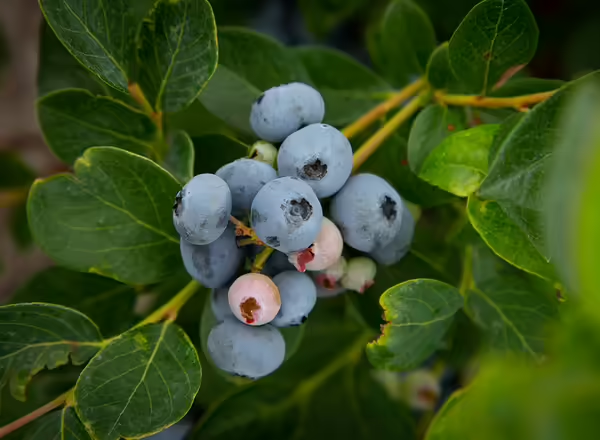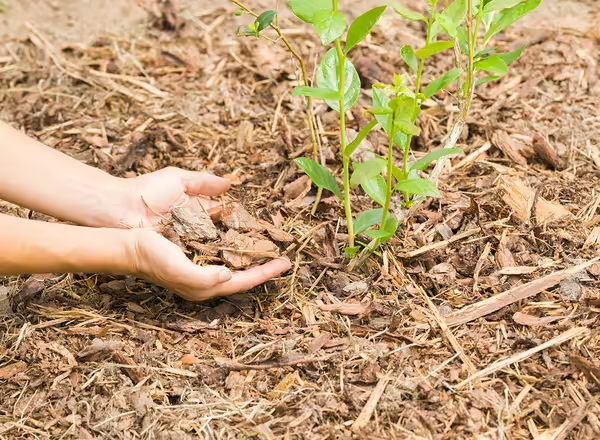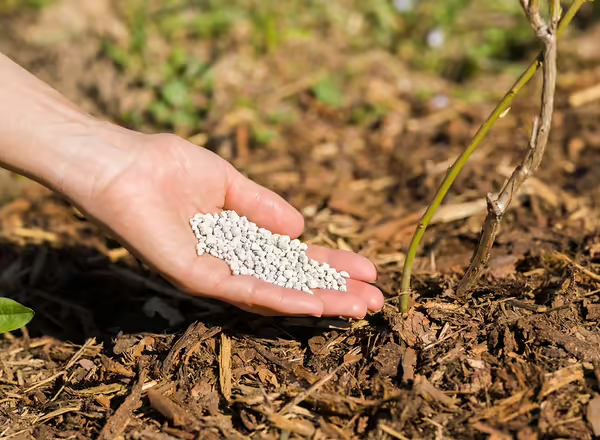
Blueberries require an acidic soil relatively high in organic matter. A soil pH of 4.8 to 5.2 is best for optimal growth. The soil should be tested prior to planting. The pH measurement refers to the relative acidity or basicity (alkalinity) of soil. The pH level is measured in numbers 1 to 14. A measurement of 7 indicates neutral; 1 to 7 indicates acidic; and 7 to 14 indicates basic.
Soils with a pH as high as 6.0 can be modified for blueberries by adding sulfur. The sulfur should be applied and incorporated at least one year before planting blueberries. To lower the pH level from 6.0 to 5.5, 0.5 pounds of sulfur per 100 square feet on sandy soils, 0.75 pounds per 100 square feet on loamy soil, and 1.0 pound sulfur per 100 square feet will be needed on clay soils. If your soil is between 5.2 and 6.2, you can also make it more acidic by adding a mixture of half acid sphagnum peat moss and half top soil. Use this soil-peat mixture in a two-foot-diameter planting hole at least twelve inches deep. If your soil pH is above 6.2, individual plants “can” be grown in large containers (at least 25 gallon capacity) buried in the garden with drainage holes cut in the bottom. Bury each container in a sunny area, and leave one to two inches of the rim above ground level. Fill the container with an acidic soil (pH 4.8 to 5.2) that is high in organic matter. Approximately 10% to 15% (volume: volume) of sphagnum peat moss is good for this purpose. Set one blueberry plant in each container.

Blueberries are shallow rooted and grow best where the water table is fourteen to twenty-two inches below the soil surface. Because of this water requirement, blueberry plants must be irrigated in most parts of Illinois. About an inch of water per week is sufficient. Do not attempt to grow blueberries unless you can supply the necessary water when rainfall is not adequate. In addition, the soil must drain freely; blue- berry plants do not tolerate standing water.

Because blueberries are very subject to drought injury, mulching with organic matter is recommended in most Illinois soils, in addition to irrigation. The mulch also supplies organic matter and helps control weeds. Although some mulches are better than others, the use of any mulch is better than no mulch at all, especially on the heavy clay soils found in much of Illinois. A deep mulch of sawdust, chopped cornstalks, or leaves is best, but other organic matter such as wood chips or straw is also useful. Apply four to six inches of mulch soon after the plants are set.
Maintain the mulch by adding two to four inches as needed. In rows, the mulch should be maintained three to four feet wide. The aisles between rows can be kept in mowed turf. On small home plantings, the entire blueberry area can be mulched to control weeds. Research at the University of Illinois has demonstrated that plants grown with mulch produce significantly larger fruit yields than plants grown without mulch, even when both plantings are irrigated equally.
Buy container-grown, two-year-old plants of medium-to-large size. If possible, avoid using plants older than three years; their extra cost is not justified, and they may be cull plants that were too weak to be sold at a younger age.
For each plant, remove one bushel of soil and mix it with one bushel of sphagnum moss (if needed). Put half of the mixture in the hole, set the plant, and fill the hole with the remaining mixture.
The plants should be set in the hole at the same depth they were growing while in the nursery, not deeper. Do not let the roots dry out during planting. Carefully spread the roots and firm the soil or soil-peat mixture over them. Blueberry plants should be spaced six to eight feet apart in rows eight to twelve feet apart. Water thoroughly after planting. Remove one-half to two-thirds of the cane growth at planting time.
Removing Flowers
Remove all flowers during the first and second year. Do not permit berries to develop because it will restrict shoot and root growth.

Do not apply fertilizer until four weeks after planting. Then, sprinkle one ounce of ammonium sulfate in a circular band twelve to eighteen inches from the base of each plant. The ammonium sulfate will provide nitrogen for growth and help maintain the acidic soil conditions required by blueberries. Do not use aluminum sulfate: it is toxic to blueberries.
In the spring of the following year, apply two ounces of ammonium sulfate per plant in late March or early April before the buds begin to swell. Increase the amount of fertilizer each year by one ounce until a total of eight ounces per plant is reached. After that, each plant should receive eight ounces annually. A complete fertilizer, such as 10-6-4 or 10-10-10, or equivalent, can be used at double the above rates if growth is not vigorous and the pH remains between
4.5 and 5.5. Check the soil pH every one or two years. Fertilizers prepared for acidic soil-loving azaleas and rhododendrons also can be used at the same rates as ammonium sulfate.
Iron deficiency of blueberries can be a problem. Symptoms are yellowing and mottling of the young leaves. Iron chlorosis in blueberries is usually an indication that the soil pH is too high, thus making iron un- available to the plant. This may be temporarily corrected by applying iron chelate to the soil or by spraying it on the foliage in amounts recommended by the manufacturer. However, most Illinois soils contain adequate amounts of iron. The soil pH should be tested and amended periodically to maintain it at the proper level.
Birds are a serious pest in blueberry plantings. As the berries ripen, the bushes can be covered with protective netting, either over individual plants or whole plantings. Although the use of noise deterrents may help to keep birds away from the planting, the usefulness of these deterrents is limited because birds become accustomed to the noises and learn to ignore them. There are so-called “hawk eye” balloons that can be flown in a planting. Birds flying by recognize the large eyelike markings on the balloon, apparently interpret it as a predator bird, and fly on. However, hopping and low-flying birds such as robins and brown thrashers are not deterred by such scare devices.
Other animals also pose problems. Rabbits and deer may eat twigs and branches when the ground is covered with snow. Fencing is warranted when this problem is severe. Voles can also be a serious problem in mulched plantings.